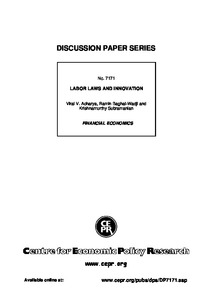Labor laws and innovation

Acharya, Viral V. ; Baghai-Wagji, Ramin ; Subramanian, Krishnamurthy
Centre for Economic Policy Research, London
CEPR - London
2009
45 p.
comparison ; dismissal ; entrepreneurship ; labour law ; research and development ; statistics ; technological change
France ; United Kingdom ; USA
Discussion Paper Series. Financial economics
7171
Law
English
Bibliogr.
"Can stringent labor laws be efficient? Possibly, if they provide firms with a commitment device to not punish short-run failures and thereby incentivize the pursuit of value-maximizing innovative activities. In this paper, we provide empirical evidence that strong labor laws indeed appear to have an ex ante positive incentive effect by encouraging the innovative pursuits of firms and their employees. Using patents and citations as proxies for innovation and a time-varying index of labor laws, we find that innovation is fostered by stringent labor laws, especially by laws governing dismissal of employees. We provide this evidence using levels-on-levels, changes-on-changes, and finally difference-in-difference regressions that exploit staggered country-level law changes. We also find that stringent labor laws disproportionately influence innovation in those sectors of the economy that are more innovation intensive. Finally, we find that while the overall effect of stringent labor laws is to dampen economic growth, laws that govern dismissal of employees are an exception: dismissal laws promote economic growth, consistent with the evidence that they encourage firm-level innovation."
Digital
The ETUI is co-funded by the European Union. Views and opinions expressed are however those of the author(s) only and do not necessarily reflect those of the European Union or the ETUI.